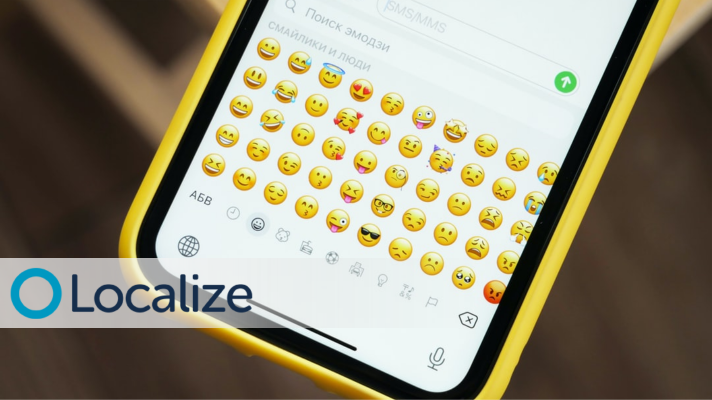Emoji, or emoticons, might seem like a straightforward bit of fun that transcends spoken and written language. However, these popular pictograms aren’t as universal as they seem. Emoji can mean different things to people in other countries.
As an international business, you need to understand that a simple smiley face or thumbs up may be perceived differently by different audiences. With that in mind, you’ll want to pay attention to translating emoji to present a unified brand image to consumers around the world.
Tips for Translating Emoji
If you work in the localization industry, you’re already aware of the difficulties involved in navigating cultural barriers. Basic translation may not be enough for full localization, particularly in cases where the original and target languages and cultures are very different.
Emoji translation adds another layer of complexity. Emoji were initially designed for texting on mobile devices, but they’re trending in all kinds of content and can be used to express a wide range of emotions.
Here are six useful tips to help you translate emoji for international audiences.
1. Do Some Research
First, spend some time researching how locals use emoji to express their feelings in different circumstances. Besides happy faces and hearts, there are many ways to use emoji in your content, depending on each targeted culture. One study found that people in different countries and regions have distinct preferences when using emoji and other symbols in social media messages.
Examples:
-
-
- Russians prefer romantic symbols such as kisses, heart eyes, and couples. 🥰
- The French use emoji with hearts much more than any other nation. 💕
- People in Arabian countries are more likely to send messages that include flowers and plants. 🪴
- Canadians typically engage with emoji that involve money. 💵
- Americans like to use LGBT-themed emoji like rainbows and same-sex couples. 🌈
-
2. Don’t Make Assumptions
It isn’t always easy to understand the full range of meanings an emoji might convey to your target audience. Keep in mind that some symbols can have more than one meaning and could easily be misconstrued.
When translating emoji, you should make sure you know the meaning of every single character. Don’t rely on your own culture to make assumptions about how an emoji will be perceived by someone with a different background. Fortunately, resources like Emoji Meanings and Emojipedia make it easy to learn how emoji are used around the world.
Example: The open hand emoji 🖐looks like a peaceful gesture to some cultures. But in Pakistan, this emoji indicates an insult to the reader. And the OK emoji 👌 might look fine to most people, but it’s considered offensive in Brazil.
3. Recognize That Images Alone May Not Be Enough
Emoji can be incredibly effective for online communication—particularly when it comes to adding emotion to text. However, the line between expressing emotion and creating confusion can be fuzzy. To keep your messages clear, it’s important to combine emoji with text. If your web content relies on emoji that won’t make sense in another cultural context, you should remove or substitute them during the localization process.
Example: Chevrolet originally announced the 2016 Cruze in a strange press release that contained nothing but emoji. Communication professionals are still divided over whether this over-the-top message offered any value at all. Unsurprisingly, the company was forced to decode its own message when consumers couldn’t understand the meaning.
4. Understand That an Emoji Can Have Several Different Meanings
Using icons to communicate may seem straightforward, but cultural differences can make things complicated. Individuals from other cultures may not have the same associations that you take for granted.
Think about universal feelings like love, anger, or fear. Even if they involve the same underlying emotion, how people relate and react to them are influenced by social norms that vary widely between different languages and cultures. An emoji may send different signals depending on the person’s social background and the context of their message.
Example: One study revealed that the classic smile emoji 😄 can elicit either a positive or negative reaction in different circumstances.
5. Always Take Context into Account
Most people never actually “learn” the meaning behind any particular emoji. Like any other form of language, we naturally use the emoji we think is appropriate to the context. When translating emoji, it’s important to understand what they mean in context. Emoji will enhance your message and generate more engagement when they make sense to your audience in context.
Example: Age and generational differences can be a factor in understanding the context of an emoji. For example, Generation Z Americans use the slightly smiling face emoji 🙂 to indicate awkwardness or discomfort. Keep in mind that emoji usage is fluid and highly dependent on context.
6. Develop an Emoji Glossary
Even with their translation challenges, emoji are far too popular to be banished from your content. On the other hand, you risk sending the wrong message to your customers if you take the localization process lightly. Before translating emoji, make sure you fully understand their purpose in the original content. That will make it easier to find the right emoji in the target language and culture.
Think about emoji as a non-verbal dialect. Setting up an emoji glossary for every language you are working with can help you develop more accurate translations in less time.
Let Localize Help You With Emoji
Localize’s translation management system makes it easy to set up a translation glossary for accurate, consistent localization of industry-specific terms. With a comprehensive glossary, your translated content will always deliver the same message and tone as your original content.
Book a conversation with Localize to learn how we can help you achieve your localization goals.







